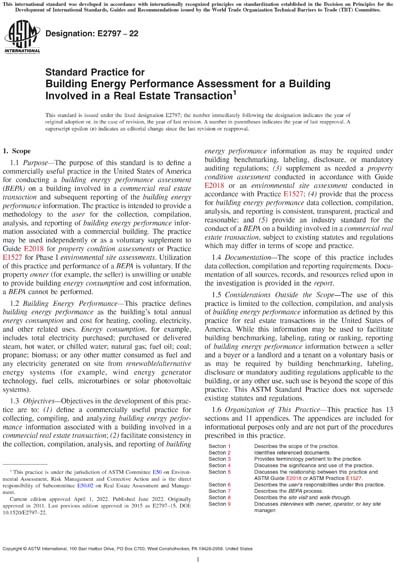Most recent
ASTM E2797-22
Standard Practice for Building Energy Performance Assessment for a Building Involved in a Real Estate Transaction
1.1Purpose - The purpose of this standard is to define a commercially useful practice in the United States of America for conducting a building energy performance assessment (BEPA) on a building involved in a commercial real estate transaction and subsequent reporting of the building energy performance information. The practice is intended to provide a methodology to the user for the collection, compilation, analysis, and reporting of building energy performance information associated with a commercial building. The practice may be used independently or as a voluntary supplement to Guide E2018 for property condition assessments or Practice E1527 for Phase I environmental site assessments. Utilization of this practice and performance of a BEPA is voluntary. If the property owner (for example, the seller) is unwilling or unable to provide building energy consumption and cost information, a BEPA cannot be performed.
1.2Building Energy Performance - This practice defines building energy performance as the building's total annual energy consumption and cost for heating, cooling, electricity, and other related uses. Energy consumption, for example, includes total electricity purchased; purchased or delivered steam, hot water, or chilled water; natural gas; fuel oil; coal; propane; biomass; or any other matter consumed as fuel and any electricity generated on site from renewable/alternative energy systems (for example, wind energy generator technology, fuel cells, microturbines or solar photovoltaic systems).
1.3Objectives - Objectives in the development of this practice are to: (1) define a commercially useful practice for collecting, compiling, and analyzing building energy performance information associated with a building involved in a commercial real estate transaction; (2) facilitate consistency in the collection, compilation, analysis, and reporting of building energy performance information as may be required under building benchmarking, labeling, disclosure, or mandatory auditing regulations; (3) supplement as needed a property condition assessment conducted in accordance with Guide E2018 or an environmental site assessment conducted in accordance with Practice E1527; (4) provide that the process for building energy performance data collection, compilation, analysis, and reporting is consistent, transparent, practical and reasonable; and (5) provide an industry standard for the conduct of a BEPA on a building involved in a commercial real estate transaction, subject to existing statutes and regulations which may differ in terms of scope and practice.
1.4Documentation - The scope of this practice includes data collection, compilation and reporting requirements. Documentation of all sources, records, and resources relied upon in the investigation is provided in the report.
1.5Considerations Outside the Scope - The use of this practice is limited to the collection, compilation, and analysis of building energy performance information as defined by this practice for real estate transactions in the United States of America. While this information may be used to facilitate building benchmarking, labeling, rating or ranking, reporting of building energy performance information between a seller and a buyer or a landlord and a tenant on a voluntary basis or as may be required by building benchmarking, labeling, disclosure or mandatory auditing regulations applicable to the building, or any other use, such use is beyond the scope of this practice. This ASTM Standard Practice does not supersede existing statutes and regulations.
1.6Organization of This Practice - This practice has 13 sections and 11 appendices. The appendices are included for informational purposes only and are not part of the procedures prescribed in this practice.
1.7Units - The values stated in inch-pound units are to be regarded as the standard. The values given in parentheses are mathematical conversions to SI units that are provided for information only and are not considered standard.
1.8This practice cannot replace education or experience and should be used in conjunction with professional judgment. Not all aspects of this practice may be applicable in all circumstances. This ASTM standard practice is not intended to represent or replace the standard of care by which the adequacy of a given professional service must be judged, nor should this practice be applied without consideration of a building's many unique aspects. The word "standard" in the title means only that the practice has been approved through the ASTM consensus process.
1.9Nothing in this practice is intended to create or imply the existence of a legal obligation for reporting of energy, performance, or other building-related information. Any consideration of whether such an obligation exists under any federal, state, local, or common law is beyond the scope of this practice.
1.10This standard does not purport to address all of the safety concerns, if any, associated with its use. It is the responsibility of the user of this standard to establish appropriate safety, health, and environmental practices and determine the applicability of regulatory limitations prior to use.
1.11This international standard was developed in accordance with internationally recognized principles on standardization established in the Decision on Principles for the Development of International Standards, Guides and Recommendations issued by the World Trade Organization Technical Barriers to Trade (TBT) Committee.
Content Provider
ASTM International [astm]






